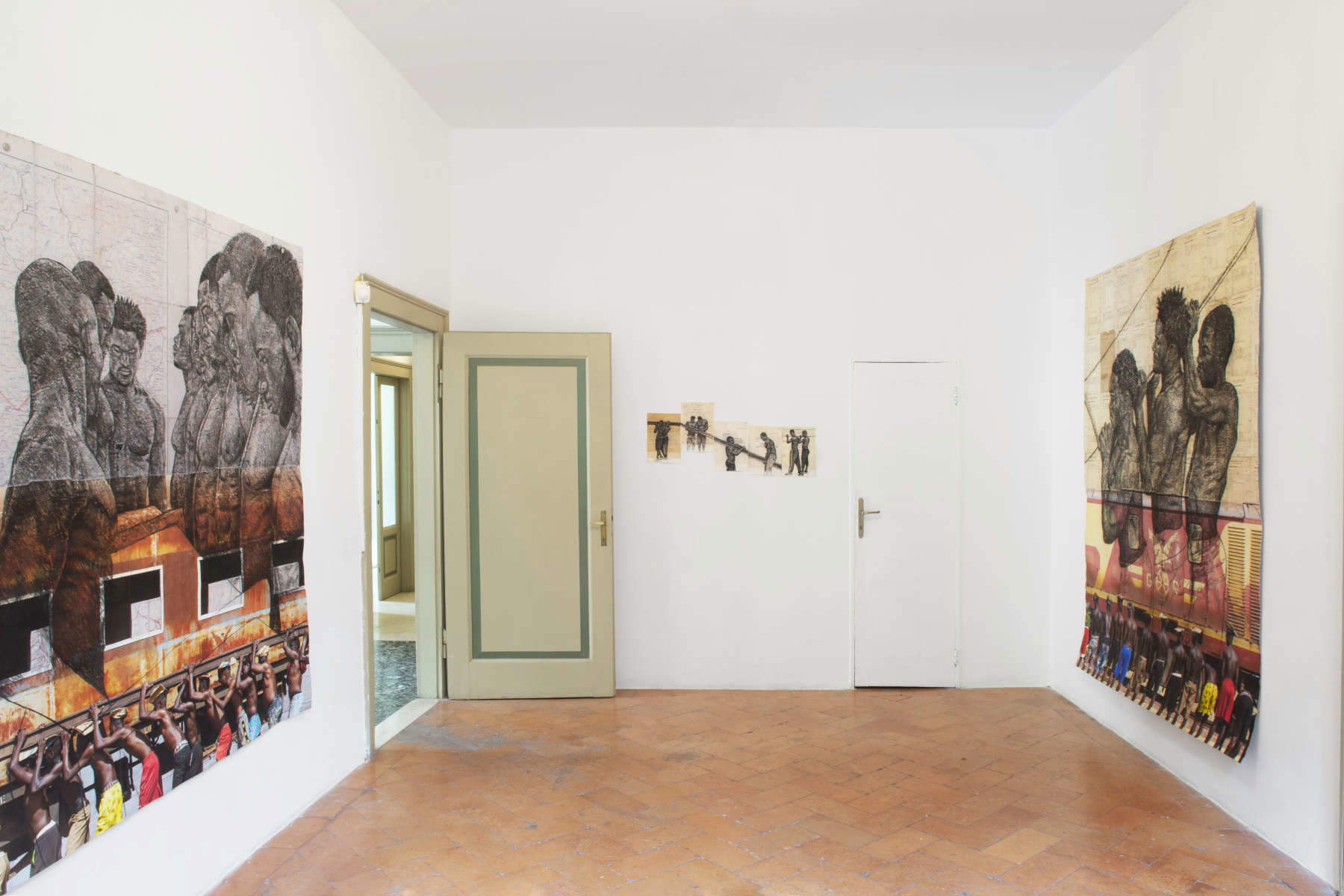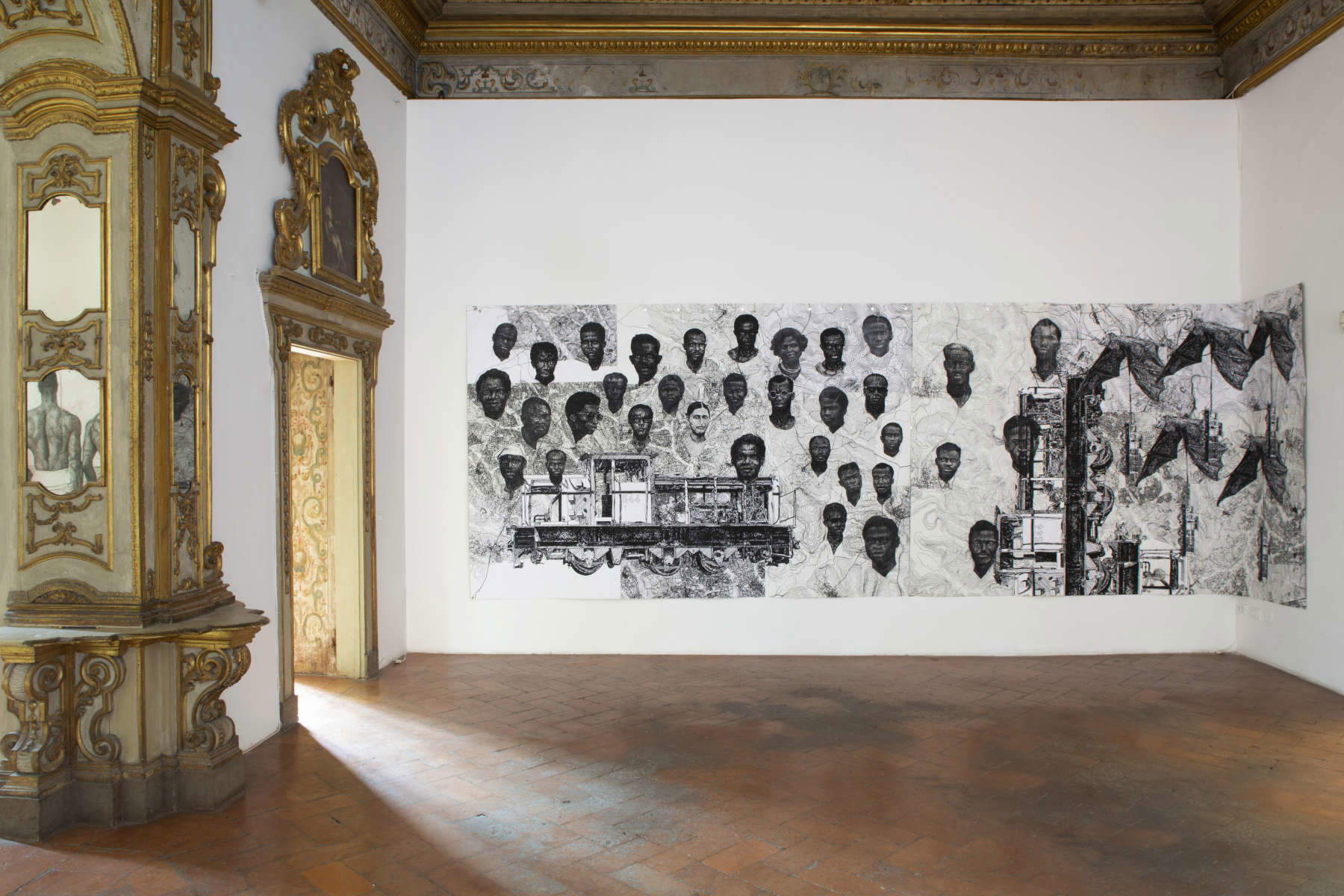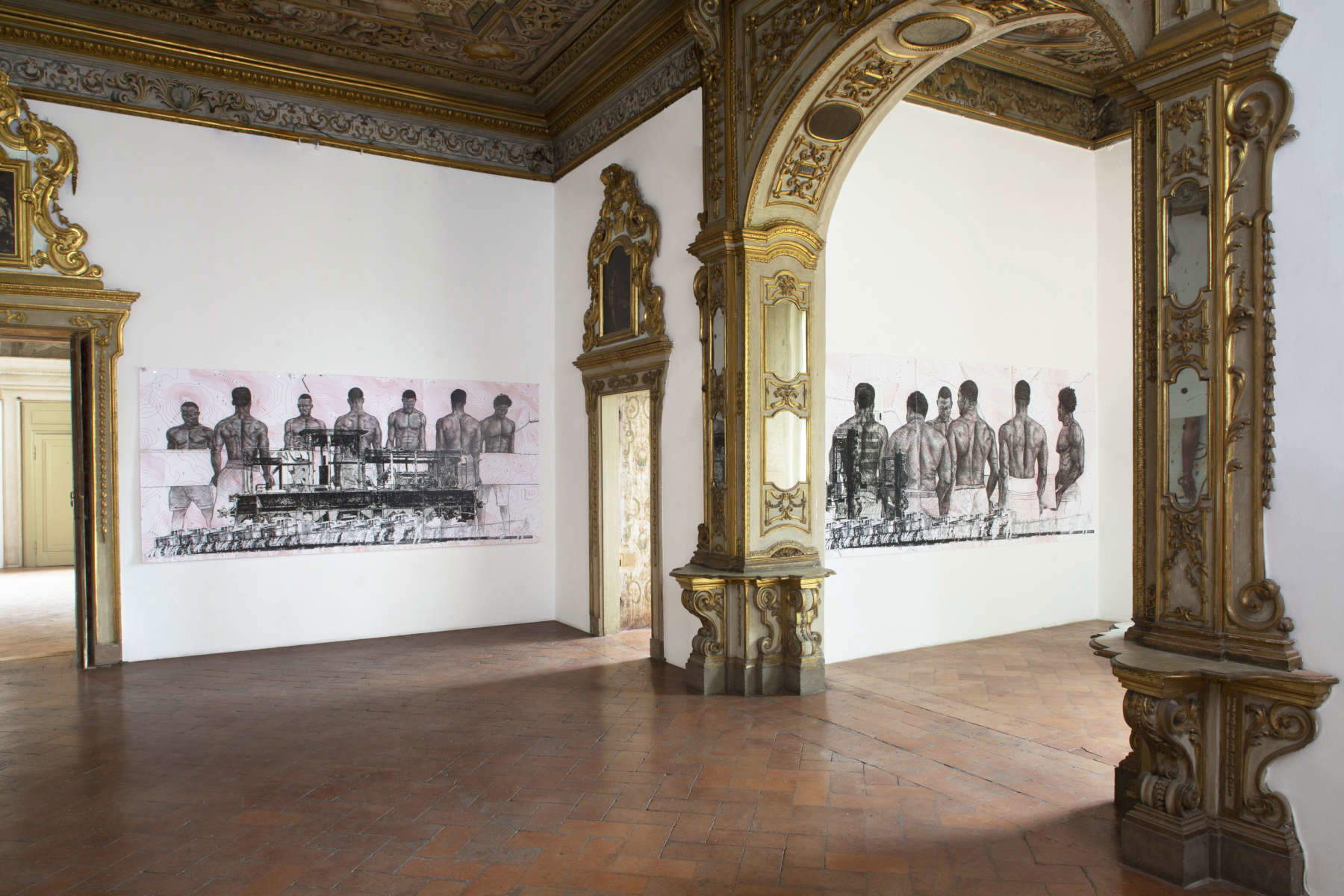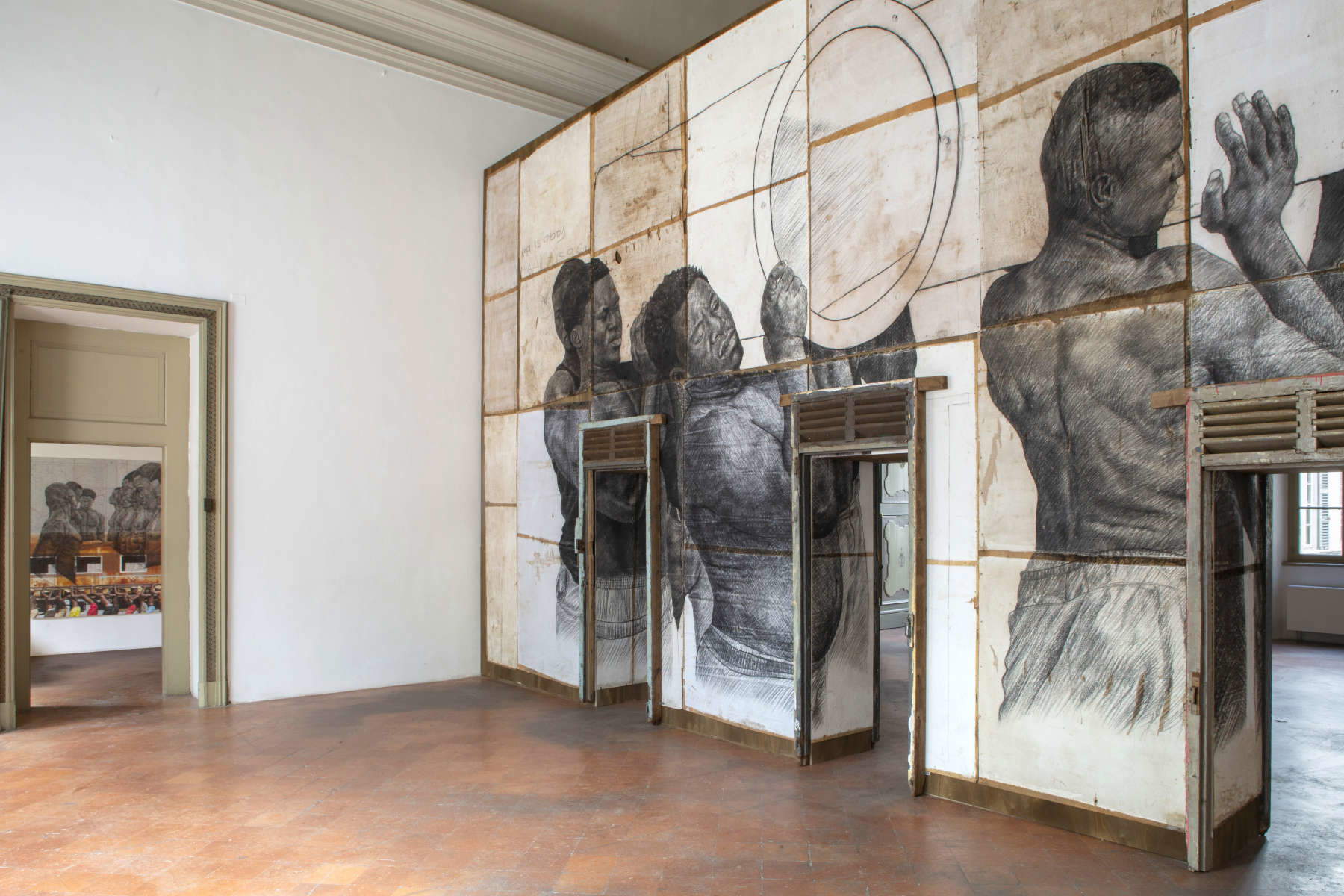"If these are the things": new exhibition of Ibrahim Mahama in Brescia.
After ten years of collaboration, the APALAZZOGALLERY gallery in Brescia presents the new solo exhibition of Ghanaian artist Ibrahim Mahama (Talame, 1987), entitled IF THESE ARE THE THINGS, open from May 25 to Sept. 22, 2024 at the Lombard gallery. Mahama’s art practice is distinguished by the use of salvaged materials such as paper documents, jute sacks, sewing machines and old doors, which the artist manipulates and transforms to explore themes such as labor exploitation, migration and the movement of goods. Mahama said he is interested in how “crisis and failure are absorbed into materials with strong references to global transition and the functioning of capitalist structures.”
This is Mahama’s fourth solo show with APALAZZOGALLERY and features a rich body of previously unseen work, combining charcoal drawings, photographs and a monumental installation composed of fragments of old painted plywood ceilings and wooden doors. The latter is reminiscent in its grandeur of the famous series Non Orientable Nkansa II. 1901 - 2030 (2016), made collaboratively at Mahama’s studio in Tamale, Ghana, with SCCA and composed of hundreds of shoemaker’s boxes.


Works and Themes
In the photographs and drawings displayed along the walls of the space, Mahama reflects on the history of Ghana ’s national rail network (the Ghana Railway, formerly known as Gold Cost Railways) on its development and impact in Ghanaian society. Rails, workshops, and locomotive repair factories, along with silos, are a source of inspiration for his artistic poetics.
In 2023, Mahama obtained consent from the Railway Development Ministry to transport some disused carriages of the national railway system to Tamale, transforming them into environments for research and experimentation. The works on display immortalize young men with athletic physiques holding up fragments of track or trying to move obsolete and rusting carriages. The weight they seem to bear is as physical as it is symbolic.
In conjunction with the opening, Mahama will give a lecture on studio practice related to architecture and work history, referring to recent public commissions and museum exhibitions. Examples of these lectures were held at the Reina Sofia Museum in Madrid and at the Diriyah Biennale Foundation during the Diriyah Contemporary Art Biennale in Saudi Arabia. A critical text by Eva Brioschi accompanies the exhibition.
“Ibrahim Mahama,” Brioschi writes, “became interested in architecture when he realized that he could overcome the limitations and static nature of painting and sculpture through a practice, characterized by a holistic approach, capable of encompassing places and environments with its changing and participatory forms, and positively influencing the imagination of entire new generations. The observation of space began with a capillary survey d e the buildings constructed in Ghana immediately after independence in 1957, during the period of Kwame Nkrumah’s enlightened presidency, such as silos, designed for the storage of seeds - cocoa, maize - in an attempt to organize an entire production chain in the territory. This dream of self-determination and economic growth foundered with Nkrumah’s ousting. Much of this architecture remained unused and inaccessible, but silently present and entrenched from south to north Ghana, like ghosts guarding a mythical but nebulous and failing past. Mahama then questioned how these simulacra could once again become active presences in a shared landscape, and found a practical answer through his installations of frayed and frayed jute sacks, sewn together to compose huge patchworks with which he has covered abandoned buildings, and not, in Ghana, and then public buildings on almost every continent. The goal is to make people’s distracted gaze aware again and to bring back, through artistic creation, new life and new possibilities for development where the usual distracted and resigned gaze recognizes only failure and decay. Later he also recovered from abandonment some of these structures, which were purchased and transformed into places to set up exhibitions and host educational and recreational events. In Ibrahim Mahama’s practice there is no difference between architecture and art. Art then is made with everything, mainly with salvaged objects and materials, to be reinserted into the productive circle, paradoxically catapulting them from the level of waste to that of luxury good, as art is normally classified. Architecture, on the other hand, becomes an infrastructure c that makes possible a new and more conscious perception of the context ; and a catalyst of forces, energies, possibilities, which arise precisely through matter recovered from destruction and oblivion.”



Notes on the artist
Ibrahim Mahama (born 1987 in Tamale, Ghana) lives and works between Accra and Tamale. He studied painting and sculpture at Kwame Nkrumah University of Science and Technology in Kumasi, graduating in 2013. His art practice incorporates reclaimed materials, including wood, paper documents, jute bags, school blackboards and old doors, to explore phenomena of globalization, migration and trade. Mahama is particularly interested in how “crisis and failure are absorbed into materials with strong references to global transition and the workings of capitalist structures.”
In his practice, textiles are central; he sees them as archival documents marked by time, form and place. After being used in the Ghanaian market, jute bags made in Southeast Asia are reused by local communities to move goods and raw materials, carrying traces of their pilgrimage. Mahama collects these fabrics and sews them together, creating monumental tapestries to cover buildings and architecture.
Mahama collaborates with local artisans, architects, technicians, artists and merchants to assemble his textile collages, and his collaborators sometimes become subjects of his work. In addition to textiles, he uses a variety of mediums and objects such as rusty sewing machines and remnants of railroad tracks, transforming them into meaningful works of art.
In recent years, Mahama has started interdisciplinary educational and training institutions near Tamale, Ghana. In 2019, it opened the Savannah Centre for Contemporary Art (SCCA), followed by Red Clay in 2020, which includes exhibition spaces, research venues and an art residency center. In 2021, he redeveloped a huge concrete silo, Nkrumah Volini, in Tamale, demonstrating his commitment to developing the contemporary art scene in his country.
 |
| "If these are the things": new exhibition of Ibrahim Mahama in Brescia. |
Warning: the translation into English of the original Italian article was created using automatic tools. We undertake to review all articles, but we do not guarantee the total absence of inaccuracies in the translation due to the program. You can find the original by clicking on the ITA button. If you find any mistake,please contact us.




























